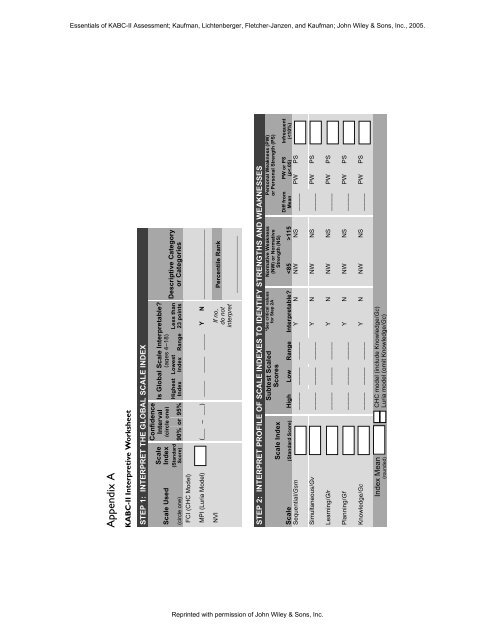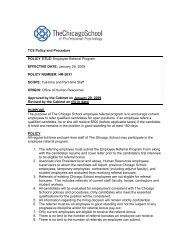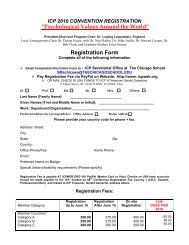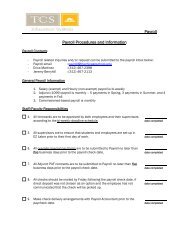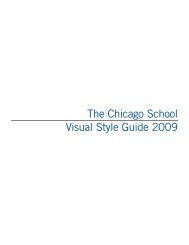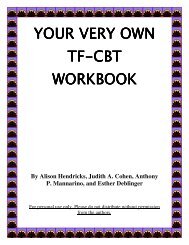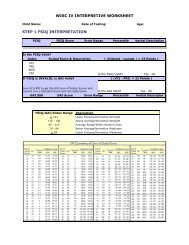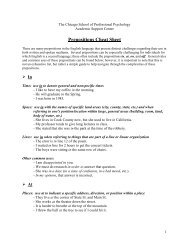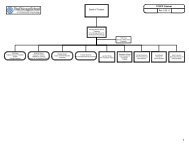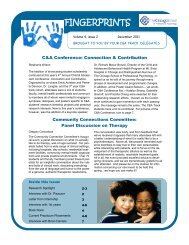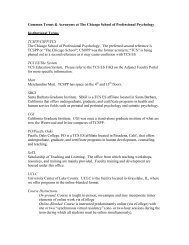Interpretive Worksheet
Interpretive Worksheet
Interpretive Worksheet
You also want an ePaper? Increase the reach of your titles
YUMPU automatically turns print PDFs into web optimized ePapers that Google loves.
Essentials of KABC-II Assessment; Kaufman, Lichtenberger, Fletcher-Janzen, and Kaufman; John Wiley & Sons, Inc., 2005.Appendix AKABC-II <strong>Interpretive</strong> <strong>Worksheet</strong>STEP 1: INTERPRET THE GLOBAL SCALE INDEXScale Used(circle one)FCI (CHC Model)ScaleIndex(StandardConfidenceInterval(circle one)Score) 90% or 95% HighestIndexIs Global Scale Interpretable?(ages 4–18)LowestIndex RangeLess than23 pointsDescriptive Categoryor CategoriesMPI (Luria Model)(___ – ___) _____ _____ _____ Y N______________________NVIIf no,do notinterpretPercentile Rank__________________STEP 2: INTERPRET PROFILE OF SCALE INDEXES TO IDENTIFY STRENGTHS AND WEAKNESSESScale IndexSubtest ScaledScores*See critical valuesfor Step 2ANormative Weakness(NW) or NormativeStrength (NS)Diff fromMeanPersonal Weakness (PW)or Personal Strength (PS)PW or PS(p
Essentials of KABC-II Assessment; Kaufman, Lichtenberger, Fletcher-Janzen, and Kaufman; John Wiley & Sons, Inc., 2005.Critical values for step 2A and steps 3A and 3B:Minimum subtest scaled score range that occurs in
Essentials of KABC-II Assessment; Kaufman, Lichtenberger, Fletcher-Janzen, and Kaufman; John Wiley & Sons, Inc., 2005.STEP 3A: INITIAL LEARNING VS. DELAYED RECALLLearning/Glr (Initial) vs. Delayed RecallSubtest ScaledScoresInterpretable?(
Essentials of KABC-II Assessment; Kaufman, Lichtenberger, Fletcher-Janzen, and Kaufman; John Wiley & Sons, Inc., 2005.STEP 4: SUPPLEMENTARY SUBTEST ANALYSIS FOR AGE 3ScaleGlobalScaleInterpretable?Sum ofScaledScoresMPI Y N 5=MeanScaledScoreSupplementarySubtestScaledScoreDiff fromMeanDifferences between supplementary subtestand mean scaled score that are significantor infrequentSig.(p
Essentials of KABC-II Assessment; Kaufman, Lichtenberger, Fletcher-Janzen, and Kaufman; John Wiley & Sons, Inc., 2005.STEP 4: SUPPLEMENTARY SUBTEST ANALYSIS FOR AGE 5ScaleScaleInterpretableinStep 2?Sum ofScaledScoresMeanScaledScoreSupplementarySubtestScaledScoreDiff fromMeanDifferences between Supplementary subtestand mean scaled score that are significantor infrequentSig.(p
Essentials of KABC-II Assessment; Kaufman, Lichtenberger, Fletcher-Janzen, and Kaufman; John Wiley & Sons, Inc., 2005.STEP 4: SUPPLEMENTARY SUBTEST ANALYSIS FOR AGES 7–12ScaleScaleInterpretableinStep 2?Sum ofScaledScoresMeanScaledScoreSupplementarySubtestScaledScoreDiff fromMeanDifferences between Supplementarysubtest and mean scaled score that aresignificant or infrequentSig.(p
Essentials of KABC-II Assessment; Kaufman, Lichtenberger, Fletcher-Janzen, and Kaufman; John Wiley & Sons, Inc., 2005.STEP 5A: PLANNED CLINICAL COMPARISONSVerbal Ability vs. Nonverbal AbilityScaled Scores Scaled Scores3-18 3-4 5 6 7-18____ Riddles ____ ____ ____ Conceptual Thinking____ Expressive Vocabulary ____ ____ Face Recognition____ Verbal Knowledge ____ ____ Story Completion____ ____ ____ ____ Triangles____ ____ ____ Pattern Reasoning____ ____ ____ ____ Hand Movements____ Block CountingRange of Scaled Scores Range of Scaled ScoresY N Uncommonly Large Range? Y N Uncommonly Large Range?Sum of Scaled Scores Sum of Scaled ScoresSTOP STOPStandard Score Standard ScoreDifferenceIs difference significant? Y NIs difference uncommonly large? Y NCluster Interpretation: Minimum DifferenceBetween Highest & Lowest Subtests ScaledScores That Occurred In
Essentials of KABC-II Assessment; Kaufman, Lichtenberger, Fletcher-Janzen, and Kaufman; John Wiley & Sons, Inc., 2005.STEP 5B: PLANNED CLINICAL COMPARISONSMemory and Learning vs. Problem-Solving AbilityScaled Scores Scaled Scores3 4 5-18 3-4 5 6 7-12 13-18____ ____ ____ Word Order ____ ____ ____ Conceptual Thinking____ ____ Face Recognition ____ ____ ____ ____ Triangles____ ____ ____ Atlantis ____ ____ ____ ____ Pattern Reasoning____ ____ Number Recall ____ ____ ____ Rover____ ____ Rebus ____ ____ Story Completion____ Block CountingRange of Scaled Scores Range of Scaled ScoresY N Uncommonly Large Range? Y N Uncommonly Large Range?Sum of Scaled Scores Sum of Scaled ScoresSTOP STOPStandard Score Standard ScoreDifferenceIs difference significant? Y NIs difference uncommonly large? Y NCluster Interpretation: Minimum DifferenceBetween Highest & Lowest Subtests ScaledScores That Occurred In < 10% Of SampleDifferences Between Cluster Scores That Are Statistically Significant Or InfrequentAge3 4 5 6 7–9 10–12 13–18Age Sig. Freq. Sig. Freq. Sig. Freq. Sig. Freq. Sig. Freq. Sig. Freq. Sig. Freq.Cluster 3 4 5 6 7–12 13–18 Cluster .05
Essentials of KABC-II Assessment; Kaufman, Lichtenberger, Fletcher-Janzen, and Kaufman; John Wiley & Sons, Inc., 2005.STEP 5C: PLANNED CLINICAL COMPARISONSMeaningful Stimuli vs. Abstract StimuliScaled Scores Scaled Scores4 5-18 4 5-12 13-18____ ____ Atlantis ____ ____ Triangles____ Face Recognition ____ ____ ____ Rebus____ Story Completion ____ ____ Pattern ReasoningRange of Scaled Scores Range of Scaled ScoresY N Uncommonly Large Range? Y N Uncommonly Large Range?Sum of Scaled Scores Sum of Scaled ScoresSTOP STOPStandard Score Standard ScoreDifferenceIs difference significant? Y NIs difference uncommonly large? Y NCluster Interpretation: Minimum DifferenceBetween Highest & Lowest Subtests ScaledScores That Occurred In < 10% Of SampleDifferences Between Cluster Scores That Are Statistically Significant Or InfrequentAge3 4 5 6 7–9 10–12 13–18Age Sig. Freq. Sig. Freq. Sig. Freq. Sig. Freq. Sig. Freq. Sig. Freq. Sig. Freq.Cluster 3–4 5–6 7–12 13–18 Cluster .05
Essentials of KABC-II Assessment; Kaufman, Lichtenberger, Fletcher-Janzen, and Kaufman; John Wiley & Sons, Inc., 2005.STEP 5D: PLANNED CLINICAL COMPARISONSVerbal Response vs. Pointing ResponseScaled Scores Scaled Scores4-6 7-18 4 5-18____ ____ Number Recall ____ ____ Word Order____ ____ Rebus ____ Face Recognition____ Expressive Vocabulary ____ ____ Atlantis____ Riddles ____ ____ Verbal KnowledgeRange of Scaled Scores Range of Scaled ScoresY N Uncommonly Large Range? Y N Uncommonly Large Range?Sum of Scaled Scores Sum of Scaled ScoresSTOP STOPStandard Score Standard ScoreDifferenceIs difference significant? Y NIs difference uncommonly large? Y NCluster Interpretation: Minimum DifferenceBetween Highest & Lowest SubtestsScaled Scores That Occurred In < 10% OfDifferences Between Cluster Scores That Are Statistically Significant Or InfrequentAgeSample 3 4 5 6 7–9 10–12 13–18AgeSig. Freq. Sig. Freq. Sig. Freq. Sig. Freq. Sig. Freq. Sig. Freq. Sig. Freq.Clusters 4 5–18 Cluster .05
Essentials of KABC-II Assessment; Kaufman, Lichtenberger, Fletcher-Janzen, and Kaufman; John Wiley & Sons, Inc., 2005.STEP 5E: PLANNED CLINICAL COMPARISONSLittle Motor Response vs. Gross Motor ResponseScaled Scores Scaled Scores4 5-6 7-18 4 5-6 7-12 13-18____ ____ Conceptual Thinking ____ Hand Movements____ Face Recognition ____ ____ ____ Triangles____ ____ Pattern Reasoning ____ ____ ____ Rover____ Block Counting ____ ____ Story CompletionRange of Scaled Scores Range of Scaled ScoresY N Uncommonly Large Range?Y N Uncommonly Large Range?Sum of Scaled Scores Sum of Scaled ScoresSTOP STOPStandard Score Standard ScoreDifferenceIs difference significant? Y NIs difference uncommonly large? Y NCluster Interpretation: Minimum DifferenceBetween Highest & Lowest Subtests ScaledScores That Occurred In < 10% Of SampleDifferences Between Cluster Scores That Are Statistically Significant Or InfrequentAge3 4 5 6 7–9 10–12 13–18Age Sig. Freq. Sig. Freq. Sig. Freq. Sig. Freq. Sig. Freq. Sig. Freq. Sig. Freq.Cluster 4 5–6 7–12 13–18 Cluster .05
Essentials of KABC-II Assessment; Kaufman, Lichtenberger, Fletcher-Janzen, and Kaufman; John Wiley & Sons, Inc., 2005.STEP 6A: GENERATE HYPOTHESES TO EXPLAIN FLUCTUATIONS IN SCALES THAT ARE NOT INTERPRETABLE.First Line of Attack: Examine planned clinical comparisons (from step 5) to identify possible hypotheses.Was index founduninterpretable instep 2?(check box if yes) Cluster that may provide hypothesesfor the subtest variability in the index Age Core Subtests Relevant to the ClustersSequential/Gsm Verbal Response vs. Pointing Response 4–18 Number Recall (Verbal) vs. Word Order (Pointing)Simultaneous/GvLearning/GlrPlanning/GfAbstract vs. Meaningful Stimuli 4 Face Recognition (Meaningful) vs. Triangles (Abstract)Memory & Learning vs. Problem Solving Ability 3-4 Face Rec. (Mem. & Learn.) vs. Triangles/Concep. Th. (Prob. Slv.)Little Motor vs. Gross Motor Response 4 Face Recognition/Concept. Thinkg. (Little) vs. Triangles (Gross)Little Motor vs. Gross Motor Response 5 Concept Thinking/Pattern Reason. (Little) vs. Triangles (Gross)Little Motor vs. Gross Motor Response 6 Concept Th./Pattern Reason. (Little) vs.Triangles/Rover (Gross)Little Motor vs. Gross Motor Response 13–18 Block Counting (Little) vs. Rover (Gross)Verbal Response vs. Pointing Response 4–18 Rebus (Verbal) vs. Atlantis (Pointing)Abstract vs. Meaningful Stimuli 4–18 Rebus (Abstract) vs. Atlantis (Meaningful)Abstract vs. Meaningful Stimuli 7–18 Pattern Reasoning (Abstract) vs. Story Completion (Meaningful)Little Motor vs. Gross Motor Response 7–18 Pattern Reasoning (Little) vs. Story Completion (Gross)Knowledge/Gc Verbal Response vs. Pointing Response 7–18 Riddles (Verbal) vs. Verbal Knowledge (Pointing)Second Line of Attack: Examine how the Core subtests within each scale complement each other.Consult Rapid References 3.3 through 3.7 to develop hypotheses.Third Line of Attack: Examine Qualitative Indicators (QIs), behavioral observations, and background information.Follow uphypotheses derived from QIs, behavioral observations, and background information by collecting supplemental data if necessary (e.g.,administer additional subtests, contact further sources for collateral information).Reprinted with permission of John Wiley & Sons, Inc.
Essentials of KABC-II Assessment; Kaufman, Lichtenberger, Fletcher-Janzen, and Kaufman; John Wiley & Sons, Inc., 2005.Step 6B: GENERATE HYPOTHESES TO EXPLAIN SUPPLEMENTARY SUBTESTS THAT ARE INCONSISTENT WITHTHE MEAN OF CORE SUBTESTS.First Line of Attack: Determine which Supplementary subtests are significantly different from the Core Subtests.a. Check box if Supplementary subtest is significantlydifferent from mean of core subtests (see step 4 results).Age3Age4Age5Age6Ages7–12Ages13–18b. Conduct only an informal examination of the planned Clinicalcomparisons, as most Supplementary subtests are excluded fromthe planned comparisons.The following supplementary tests are included in step 5’s clusters:- Expressive Vocabulary (Gc subtest) is in the Verbal Ability cluster.- Verbal Knowledge (Gc subtest) is in the Verbal Ability and PointingResponse clusters.- Hand Movements (Gsm Subtest) is in the Gross-motor responseand Nonverbal Ability clusters.- Block Counting (Gv subtest) is in the Little Motor cluster.Supplementary SubtestNumber RecallGestalt ClosureHand MovementsVerbal KnowledgeFace RecognitionBlock CountingStory CompletionExpressive VocabularyTrianglesSecond Line of Attack: Examine how Supplementary and Core subtests within each scale complement each other.Consult Rapid References: 3.4, 3.5, and 3.7 to develop hypotheses.Third Line of Attack: Examine Qualitative Indicators (QIs), behavioral observations, & background information.Follow uphypotheses derived from QIs, behavioral observations, and background information by collecting supplemental data if necessary(e.g., administer additional subtests, contact further sources for collateral information).Reprinted with permission of John Wiley & Sons, Inc.


